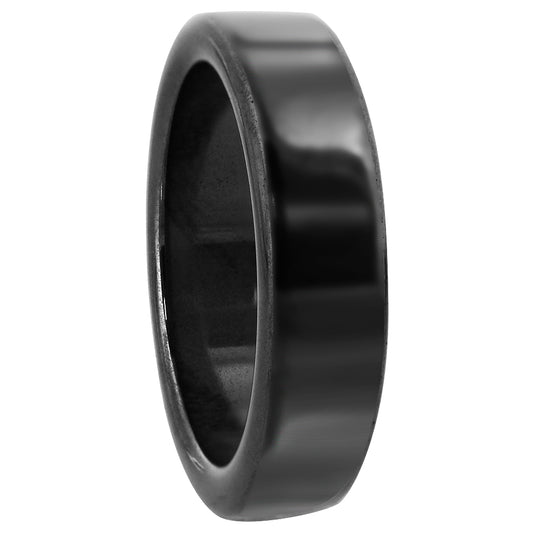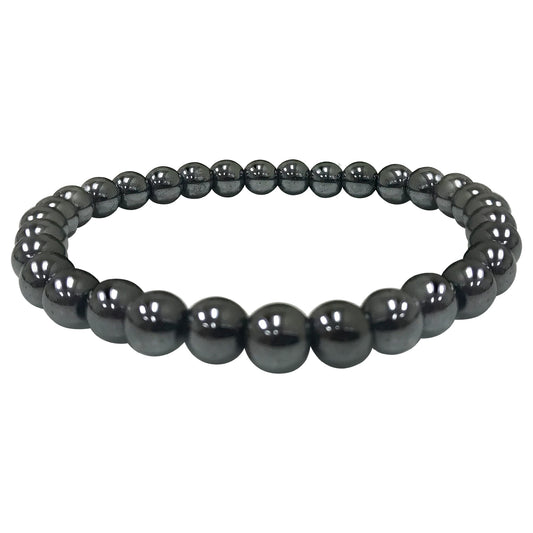Hematite Stone
-
Regular price $25.99 USDRegular priceUnit price / per
-
Regular price $12.99 USDRegular priceUnit price / per
-
Regular price $7.99 USDRegular priceUnit price / per

Hematite gets its name from the Greek word "haimatitis," which means blood-red, referencing the red hue of the mineral in its powdered form. Known for its density and hardness, hematite stones are highly valued as the primary ore of iron, due to their rich iron content and abundance. The mineral can be found in several forms, such as polished hematite stones with a sleek metallic finish, and as hematite worry stones or palm stones that are smooth and ideal for stress relief.
There are various types of hematite, each with unique appearances. Specular hematite features steel-gray crystals with a brilliant metallic luster. Micaceous hematite is made of thin, scaly forms, while iron roses consist of crystal clusters arranged like petals. Hematite can also appear as small, black rhombohedral crystals that sometimes exhibit an iridescent shine. As a gemstone, hematite is often carved into smooth shapes, such as hematite stone bracelets, rings, or necklaces, though it is rarely faceted due to its natural structure.

In addition to its ornamental uses, hematite stone benefits are widely acknowledged in crystal healing. It is believed to provide grounding, protection, and a sense of stability, making it popular in jewelry like a hematite stone bracelet or a hematite stone necklace. These accessories allow the wearer to carry its balancing energy close to their body. Despite its association with the color red due to its name, real hematite stone ranges in appearance from metallic gray to black, with reddish-brown tones visible in powdered or thin sliver forms. Hematite has also been used historically as a pigment, giving red hues to ancient paints and dyes.
Hematite Jewelry

Hematite jewelry is known for its distinctive metallic sheen and deep gray or black coloration, making it a unique and versatile addition to any collection. Hematite is a mineral rich in iron content, which gives it its characteristic heavy feel and smooth, polished finish. Its reflective surface adds a touch of modern elegance, whether crafted into bracelets, rings, necklaces, or earrings. This mineral is popular for creating both casual and formal pieces, seamlessly blending into various styles while adding a subtle yet bold statement to any outfit.
Hematite jewelry is more than just visually appealing—it is also valued for its metaphysical properties. Many people wear hematite pieces for their believed grounding and balancing effects. The stone is often associated with stability, protection, and mental clarity, making it a popular choice for those seeking a sense of calm and focus. Hematite bracelets and rings are particularly favored for their direct contact with the skin, allowing wearers to carry these energies throughout the day. Additionally, hematite necklaces or pendants can make striking focal pieces, offering both style and a sense of well-being. With its combination of beauty and spiritual significance, hematite jewelry has a timeless appeal that makes it a favorite among crystal enthusiasts and fashion lovers alike.
What are the benefits of hematite stones?
Hematite stones are often associated with grounding, protection, and emotional stability. They are believed to help balance the body’s energy, enhance focus, and reduce stress or anxiety. Hematite is also said to boost confidence and courage, making it a popular choice in crystal healing practices.
How to identify a real hematite stone?
Real hematite stone is dense and has a cool, smooth surface with a metallic gray or black appearance. When scratched or rubbed, it might leave a reddish streak, which is a key indicator of genuine hematite. Polished hematite stones can be very reflective, almost mirror-like, whereas imitations may lack this level of luster.
What is a hematite stone bracelet used for?
Hematite stone bracelets are worn for their believed healing properties, such as providing a sense of calm, balance, and protection. Many wearers choose these bracelets to stay grounded during stressful situations or to enhance their focus and clarity. Additionally, they are worn as a stylish accessory that complements various outfits.
How to care hematite stone jewelry?
To keep your hematite stone jewelry in good condition, it is recommended to clean it gently with a soft cloth and mild soapy water. Avoid using harsh chemicals or ultrasonic cleaners, as these can damage the stone. Store your hematite jewelry separately from other pieces to prevent scratching.
Are hematite stones magnetic?
Natural hematite is not magnetic; however, certain processed or synthetic versions of hematite can have magnetic properties. This has led to some confusion, as many hematite jewelry pieces labeled as "magnetic" are actually made from magnetized hematite-like materials, rather than pure hematite.
Can hematite be used in jewelry for daily wear?
Yes, hematite is a durable stone and can be used in various types of jewelry, including rings, bracelets, and necklaces, making it suitable for daily wear. However, due to its hardness, care should be taken to avoid drops or impacts that could cause chipping or breaking. Proper care will help maintain its shine and appearance over time.



